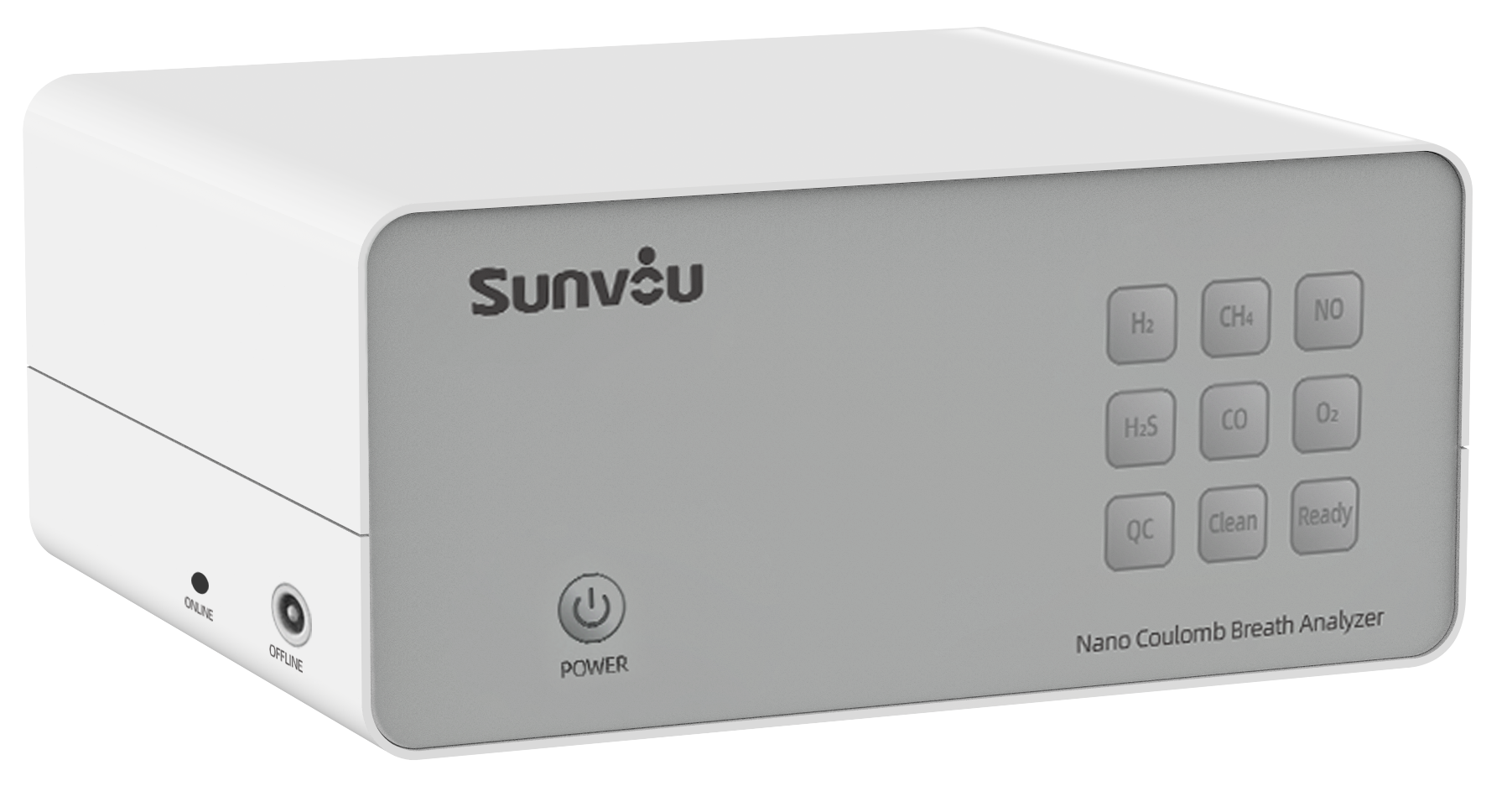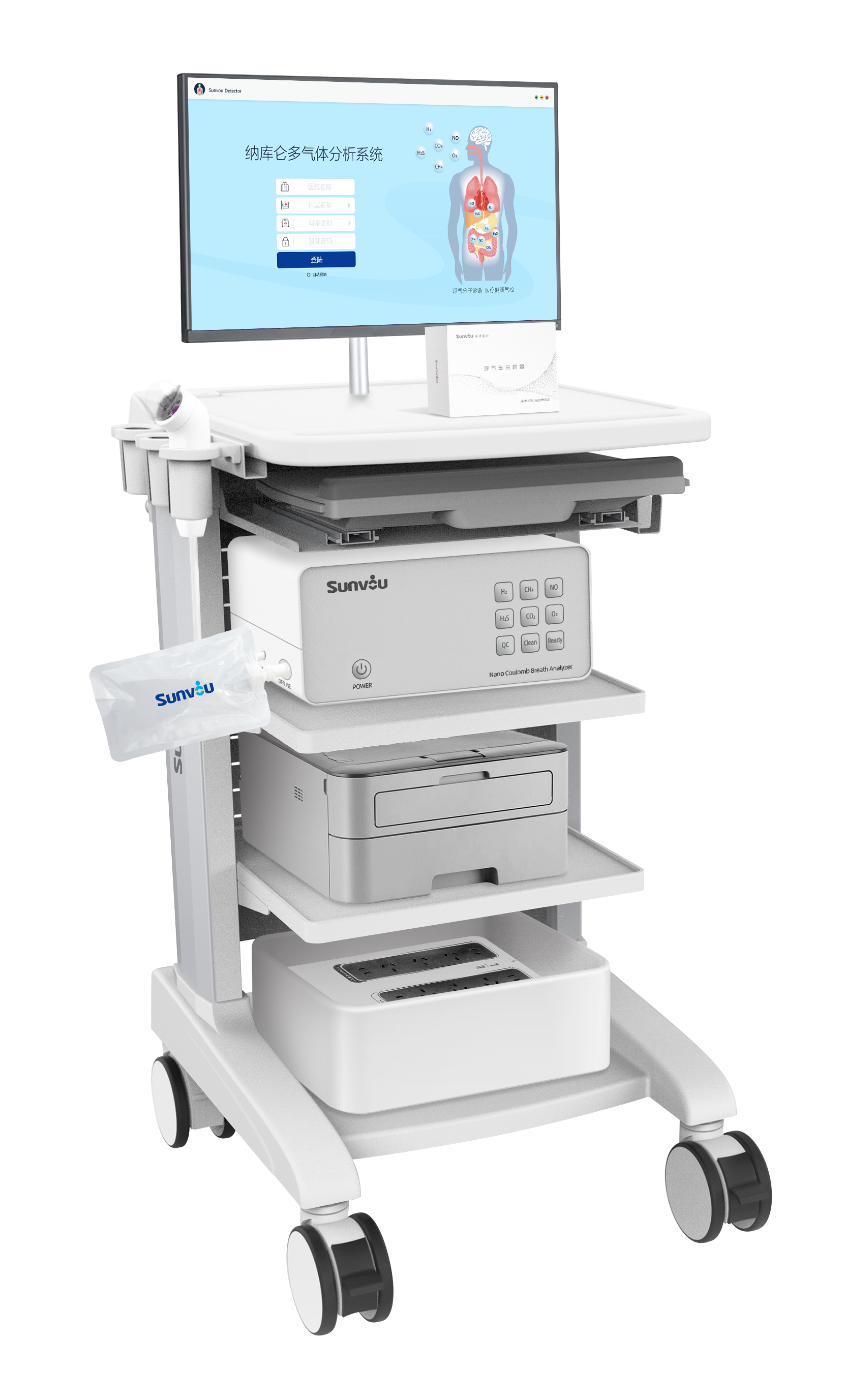GASTRO - DA7349
SUNVOU GASTRO DA7349 SIBO Measurement Device
1. Device measures Gastro-intestinal Parameters from Exhaled Human Breath.
2. H2, CH4 and H2S can be measured separately all-in-one device.
3. Both Online-Direct Connected to Device and Offline-Off-Site-Sampling can be done properly.
4. Biomarkers: H2 + CH4 + H2S + NO + CO
5. Auto-Calibration
6. Measurement Range: 0-200 ppb for H2 and 0-75ppb for CH4
The SIBO breath test measures the levels of certain gases produced by bacteria in the small intestine. The primary gases measured are hydrogen (H2) and methane (CH4). Here's how the test typically works:
Baseline Breath Sample: Before ingesting any substances, a baseline breath sample is collected. This establishes the normal levels of hydrogen and methane in the individual's breath.
Ingestion of Substrate: The patient is then given a substrate, typically either lactulose or glucose. These are carbohydrates that are not fully absorbed in the small intestine.
Bacterial Fermentation: If there is an overgrowth of bacteria in the small intestine, they will ferment the unabsorbed carbohydrates, producing hydrogen and/or methane gas.
Breath Sample Collection: Over a specific period (usually 2-3 hours), breath samples are collected at regular intervals. The patient breathes into a collection device or bag.
Gas Analysis: The collected breath samples are then analyzed for the concentrations of hydrogen and methane. Elevated levels of these gases compared to the baseline suggest bacterial overgrowth in the small intestine.
The interpretation of the test results considers the pattern and timing of gas production. Elevated levels of hydrogen early in the testing period suggest bacterial overgrowth in the proximal small intestine, while elevated methane later in the testing period may indicate overgrowth in the distal small intestine.
It's important to note that the choice of substrate (lactulose or glucose) can influence the characteristics of gas production and may vary based on the laboratory or healthcare provider's protocol.
Biomarkers of latest SIBO Testing:
Hydrogen (H2): When bacteria in the small intestine ferment carbohydrates, they produce hydrogen gas. Elevated levels of hydrogen in the breath after ingestion of a test sugar solution (usually glucose or lactulose) indicate that bacteria are fermenting the sugar in the small intestine, suggesting the presence of SIBO.
Methane (CH4): Some types of bacteria in the gut can convert hydrogen into methane. High levels of methane in the breath are associated with constipation-predominant symptoms and have been linked to a specific form of bacterial overgrowth involving methanogenic archaea. Methane production is particularly associated with slower transit times through the intestines.
Hydrogen Sulfide (H2S): Detects Sulfur-Reducing Bacteria: H2S is produced by sulfur-reducing bacteria in the gut. Elevated levels may indicate an overgrowth of these bacteria, which are not detected by standard hydrogen (H2) or methane (CH4) measurements.
Nitric Oxide (NO): Indicates Inflammatory Activity: NO is a marker of inflammation in the gut. Elevated NO levels can indicate inflammation or immune responses that may be associated with bacterial overgrowth or other gastrointestinal conditions.
SUNVOU GASTRO DA7349 SIBO Measurement Device
1. Device measures Gastro-intestinal Parameters from Exhaled Human Breath.
2. H2, CH4 and H2S can be measured separately all-in-one device.
3. Both Online-Direct Connected to Device and Offline-Off-Site-Sampling can be done properly.
4. Biomarkers: H2 + CH4 + H2S + NO + CO
5. Auto-Calibration
6. Measurement Range: 0-200 ppb for H2 and 0-75ppb for CH4
The SIBO breath test measures the levels of certain gases produced by bacteria in the small intestine. The primary gases measured are hydrogen (H2) and methane (CH4). Here's how the test typically works:
Baseline Breath Sample: Before ingesting any substances, a baseline breath sample is collected. This establishes the normal levels of hydrogen and methane in the individual's breath.
Ingestion of Substrate: The patient is then given a substrate, typically either lactulose or glucose. These are carbohydrates that are not fully absorbed in the small intestine.
Bacterial Fermentation: If there is an overgrowth of bacteria in the small intestine, they will ferment the unabsorbed carbohydrates, producing hydrogen and/or methane gas.
Breath Sample Collection: Over a specific period (usually 2-3 hours), breath samples are collected at regular intervals. The patient breathes into a collection device or bag.
Gas Analysis: The collected breath samples are then analyzed for the concentrations of hydrogen and methane. Elevated levels of these gases compared to the baseline suggest bacterial overgrowth in the small intestine.
The interpretation of the test results considers the pattern and timing of gas production. Elevated levels of hydrogen early in the testing period suggest bacterial overgrowth in the proximal small intestine, while elevated methane later in the testing period may indicate overgrowth in the distal small intestine.
It's important to note that the choice of substrate (lactulose or glucose) can influence the characteristics of gas production and may vary based on the laboratory or healthcare provider's protocol.
Biomarkers of latest SIBO Testing:
Hydrogen (H2): When bacteria in the small intestine ferment carbohydrates, they produce hydrogen gas. Elevated levels of hydrogen in the breath after ingestion of a test sugar solution (usually glucose or lactulose) indicate that bacteria are fermenting the sugar in the small intestine, suggesting the presence of SIBO.
Methane (CH4): Some types of bacteria in the gut can convert hydrogen into methane. High levels of methane in the breath are associated with constipation-predominant symptoms and have been linked to a specific form of bacterial overgrowth involving methanogenic archaea. Methane production is particularly associated with slower transit times through the intestines.
Hydrogen Sulfide (H2S): Detects Sulfur-Reducing Bacteria: H2S is produced by sulfur-reducing bacteria in the gut. Elevated levels may indicate an overgrowth of these bacteria, which are not detected by standard hydrogen (H2) or methane (CH4) measurements.
Nitric Oxide (NO): Indicates Inflammatory Activity: NO is a marker of inflammation in the gut. Elevated NO levels can indicate inflammation or immune responses that may be associated with bacterial overgrowth or other gastrointestinal conditions.
SUNVOU GASTRO DA7349 SIBO Measurement Device
1. Device measures Gastro-intestinal Parameters from Exhaled Human Breath.
2. H2, CH4 and H2S can be measured separately all-in-one device.
3. Both Online-Direct Connected to Device and Offline-Off-Site-Sampling can be done properly.
4. Biomarkers: H2 + CH4 + H2S + NO + CO
5. Auto-Calibration
6. Measurement Range: 0-200 ppb for H2 and 0-75ppb for CH4
The SIBO breath test measures the levels of certain gases produced by bacteria in the small intestine. The primary gases measured are hydrogen (H2) and methane (CH4). Here's how the test typically works:
Baseline Breath Sample: Before ingesting any substances, a baseline breath sample is collected. This establishes the normal levels of hydrogen and methane in the individual's breath.
Ingestion of Substrate: The patient is then given a substrate, typically either lactulose or glucose. These are carbohydrates that are not fully absorbed in the small intestine.
Bacterial Fermentation: If there is an overgrowth of bacteria in the small intestine, they will ferment the unabsorbed carbohydrates, producing hydrogen and/or methane gas.
Breath Sample Collection: Over a specific period (usually 2-3 hours), breath samples are collected at regular intervals. The patient breathes into a collection device or bag.
Gas Analysis: The collected breath samples are then analyzed for the concentrations of hydrogen and methane. Elevated levels of these gases compared to the baseline suggest bacterial overgrowth in the small intestine.
The interpretation of the test results considers the pattern and timing of gas production. Elevated levels of hydrogen early in the testing period suggest bacterial overgrowth in the proximal small intestine, while elevated methane later in the testing period may indicate overgrowth in the distal small intestine.
It's important to note that the choice of substrate (lactulose or glucose) can influence the characteristics of gas production and may vary based on the laboratory or healthcare provider's protocol.
Biomarkers of latest SIBO Testing:
Hydrogen (H2): When bacteria in the small intestine ferment carbohydrates, they produce hydrogen gas. Elevated levels of hydrogen in the breath after ingestion of a test sugar solution (usually glucose or lactulose) indicate that bacteria are fermenting the sugar in the small intestine, suggesting the presence of SIBO.
Methane (CH4): Some types of bacteria in the gut can convert hydrogen into methane. High levels of methane in the breath are associated with constipation-predominant symptoms and have been linked to a specific form of bacterial overgrowth involving methanogenic archaea. Methane production is particularly associated with slower transit times through the intestines.
Hydrogen Sulfide (H2S): Detects Sulfur-Reducing Bacteria: H2S is produced by sulfur-reducing bacteria in the gut. Elevated levels may indicate an overgrowth of these bacteria, which are not detected by standard hydrogen (H2) or methane (CH4) measurements.
Nitric Oxide (NO): Indicates Inflammatory Activity: NO is a marker of inflammation in the gut. Elevated NO levels can indicate inflammation or immune responses that may be associated with bacterial overgrowth or other gastrointestinal conditions.
Break down Gastro Biomarkers with SIBO Breath Testing!
Accurate Diagnosis: Provide precise and reliable results for diagnosing Small Intestinal Bacterial Overgrowth (SIBO), aiding healthcare professionals in making informed treatment decisions.
Non-Invasive Screening: The SIBO breath test offers a non-invasive and patient-friendly method for assessing bacterial overgrowth in the small intestine, minimizing discomfort for individuals undergoing testing.
Comprehensive Assessment: Enables healthcare professionals to conduct a comprehensive assessment of patients with gastrointestinal symptoms, helping to identify underlying causes and tailor treatment plans accordingly.
Targeted Treatment Planning: Facilitate targeted and personalized treatment strategies by identifying the specific types of bacteria causing SIBO, allowing for more effective antibiotic selection.
Efficient Workflow: Streamline clinical workflows with a simple and efficient testing process, reducing the burden on healthcare providers and enhancing patient care.
Evidence-Based Decision-Making: Empower healthcare professionals with evidence-based insights, supporting data-driven decision-making in the management of gastrointestinal disorders.
Quantitative Results: Offer quantitative measurement of hydrogen and methane gas levels in the breath, providing healthcare professionals with clear and objective indicators of SIBO severity.
Patient Education Support: Enhance patient education by providing clear and interpretable results, fostering communication between healthcare professionals and patients about the significance of SIBO testing and its implications for treatment.
Monitoring Treatment Efficacy: Facilitate ongoing monitoring of treatment efficacy by offering follow-up SIBO breath tests, allowing healthcare professionals to assess the success of interventions and make necessary adjustments.
Improved Patient Outcomes: Contribute to improved patient outcomes by facilitating early and accurate diagnosis of SIBO, enabling timely and targeted interventions to alleviate symptoms and enhance overall digestive health.
★★★★★
“Sunvou's gastro breath device has significantly improved our ability to diagnose gastrointestinal conditions quickly and non-invasively. Its reliability and efficiency have enhanced patient care and streamlined our diagnostic processes."
Director of New Life Hospitals.



